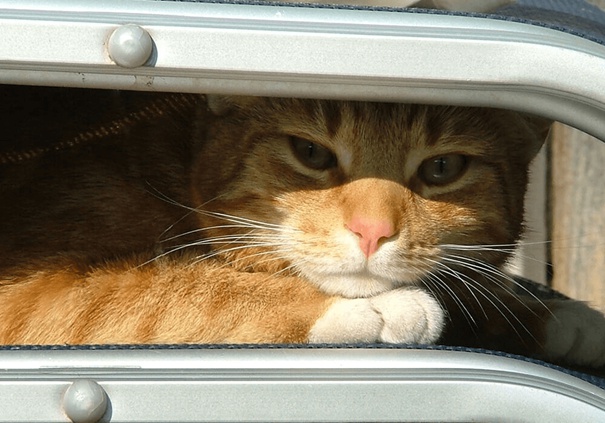My cat has gone missing, when should I start to worry?
If your cat is missing for some time, you are understandably concerned about its safety. Your missing cat may return, but how long should you wait for them to come home? This article shares what to do if your cat goes missing and when you should start searching for them.

Reading time : 8 min
A missing cat can send a wave of emotions to any pet owner. Cats have a roaming nature, but a free-to-roam cat is less common here than in the United Kingdom. Scientists find that the average male cat roams 1,500 feet away from home, while females roam only 225 feet.
If you have an outside cat, you might not be too worried if your cat goes missing. However, you're likely more concerned if your indoors-only cat escapes outside. When a cat goes out alone, loud noises, other animals, cars, and people may frighten them, chasing them to hide. But, you might wonder how long a cat will hide if scared
The average missing cat hides for two hours out of fear. An extremely scared feline, such as a lost kitten, may hide for much longer.
TOPICS
Why do cats go missing?

Why hasn’t my cat come back home?
Cats act on instinct and may leave home for various reasons. The cat may be too curious and wander off on its own, perhaps through an open door or window. You may also have a missing cat after they run out of fear or because they’re hungry and see a tasty-looking bird outside.
Cats are also territorial and may go missing after an intruder cat encroaches on their domain.
If they’re in heat, cats may leave their home to find a mate, especially if your cat picks up another cat’s scent in the area. Stress after a move or other significant changes in the household can disorient your cat, leading to its disappearance. Illness or an injury can also delay your cat from returning home.
Can a cat get lost?
Cats may get lost, especially if frightened or angered, but they have a powerful navigation system to help them return home. Research and extensive studies show cats have an innate homing mechanism. The theory on why cats can find their way back home might relate to the earth’s geomagnetism and how cats use it as a compass.
Cats also navigate with a powerful sense of smell that’s14 times stronger than humans. Feline olfactory systems are robust because they have two scent receptors. One scent receptor is found in the nose and operates the same as in other animals. The second scent receptor, in the mouth, detects pheromone signals they and other cats leave. If you’ve seen your cat brush up against your couch, legs, and a wall, they’re marking the area with pheromones.
How long do cats go missing for?

Each cat varies in how long it goes missing. Some people wonder when to stop looking for a lost cat, but there’s no actual answer. Cats can go missing for days, months, or even years. The animal world is full of stories of cats that returned home years after pet owners gave up hope. One such tale is 2022’s story of Bobby, a missing cat reunited with his family after seven years.
The difference between indoor and outdoor cats
How long a cat is missing often depends on its territory, why it went missing, and its demeanor. If your outside cat is prone to adventure and hunting, they may have strayed too far after their prey and will return home later.
When an indoor cat goes missing, you must take action when they don’t return after several hours. Cats who spend their lives indoors may frighten easily and run away out of fear.
Once your missing cat does return, you should check it over carefully for injuries, fleas, ticks, and parasites.
Cats’ food and water needs
Your cat can go without food for almost two weeks if they still have access to water. Two weeks without food will cause health problems as your cat will lose vital nutrients. Cats can only go three days without water, but even 24 hours without water marks the beginning of dehydration. Organ damage and illness set in with a lack of water.
Find out the 5 most important steps to find your lost pet
All the information you need to find your beloved companion
What to do when your cat is not coming home?

If your indoor-only cat hasn’t come home after several hours, you may start to worry. You should begin your search for your lost pet immediately, as the earlier the start, the better. Here’s what to do if your cat goes missing:
#1: Check every area of your home
Is your cat possibly hiding in your home? Check behind bookcases, underneath sofas, and anywhere else a cat may seek. Don’t forget to look at any favorite spots of your missing cat. Shake cans of their favorite treats, and call their name to try to entice them out.
#2: Let others help in your search
Take your search for your missing cat outside your home and talk to your neighbors. Have them look for your cat in their garden, sheds, or deck. You should focus on any area that may be tight and easy for your cat to get trapped. You can cover more ground when you search for your missing cat with friends, family, and neighbors.
#3: Contact your vet and officials
Call your vet's office and tell them your cat is missing so they can keep an eye out for your cat. You should also contact local animal authorities, such as the animal control department and the local shelter.
#4: Make a lost cat flyer
One of the best tips on how to find a lost cat is to make a lost pet flyer. A flyer will let people outside your household know about your missing cat. Create a flyer with a recent picture of your cat, identifying information, and contact information. Once you create the flyer, post it in your neighborhood on fences, posts, and in local businesses (with permission).
#5: Post about your missing cat on lost pet websites
The Internet is a vital tool for helping to find your cat. Websites like Pet FBI and Petco Love Lost let cat owners publish a lost pet ad, while PawBoost connects you to local lost and found pet Facebook groups within your area. You can also browse these online databases to see if anyone reported finding your missing cat.
How to prevent your cat from running away ?

Getting your cat fixed
A spayed or neutered cat is less likely to run away. Cats in heat can have an insatiable desire to leave their home searching for a mate. A spayed or neutered cat has a lower desire to roam.
Spaying and neutering your cat also includes health benefits, such as the lowered risk of mammary cancer, testicular cancer, and other illnesses.
You can safely neuter or spay your kitten when they’re as young as eight weeks old. Most kittens undergo spaying or neutering around five to six months old. The American Veterinary Medical Association now recommends cat owners and animal shelters spay or neuter at five months or earlier to reduce overpopulation.
Training your cat to respond via clicker
Clicker training is a popular form of cat training. It involves training your cat to respond to the “click” sound with food and a reward for your cat, so it responds to your command.
Not only does it keep your cat engaged, but it also helps stave off boredom and can help with behavioral issues. If your cat is missing, using a clicker may help you call your cat back home.
Use a GPS pet tracker
A cat GPS tracker lets you watch your cat wherever they are. GPS trackers are small and light; your cat can wear them comfortably. You can see your cat's location in real-time, and if they go missing, you can trace their path to bring them home. The GPS tracker collar also features a call-back feature which you use to call them for dinner or to come inside. Tracking your cat via GPS provides peace of mind for owners of both indoor and outdoor cats.
Do you need help to find your pet?
In this guide, you will find 5 key steps to follow to conduct an effective search and to find your pet as soon as possible.
Can I consider not letting my cat outside ?

Many cat owners don’t let their cats outside. In the United States, 63% of cats live entirely indoors. Keeping your cat indoors is the best way to protect them from outside dangers, such as vehicles, other animals, and parasites.
The approaches for cat owners who let their cats go outside differ. Some may only let their cats outside under close supervision, while others may have a cat door that allows cats to come and go as they please. Other cat owners may limit their cats’ access to the outdoors, as new technology enables pet owners to program access to the pet door, so they know the cat exits only when permitted.
You should look at your options for keeping your cat indoors versus outdoors. Letting your cat outside regularly might be hard if you live in a city apartment. In addition, safety is a concern in areas with high traffic. But if you live in the country, you may let your cat come and go with a pet door. To prevent their cats from running away, some cat owners might prefer keeping their cats inside from outside dangers and dishonest people. This decision, even though going against a cat’s instinct, is a good way to keep a cat safe.
Keeping an indoor cat happy
An indoor-only cat needs stimulation and attention to ward off boredom. Bored cats may run away or act out of frustration. In addition to addressing their physical needs with clean litter, food, and water, cat parents should engage and entertain their cats.
Animal experts advise cat owners to play with their pets for at least 30 minutes daily. This daily play session is ideal for bonding and letting your cat indulge in its instincts. Toys that help cats simulate hunting, like laser pointers or other chasing toys, are ideal. Installing vertical climbing options like a cat tree or cat condo lets them get high off the ground to safety, sharpen their claws, and exercise. If your cat craves a little adventure, consider using a harness and leash to take them out on small supervised excursions.
One of the best things you can do as an indoor cat owner is to offer safe spaces for your cat. Cats crave security and want space where they can feel secure. A covered cat bed, cat cave, or any other cozy nook that’s just for them will help them feel safe. Sometimes a cat needs to hide if it feels threatened or scared, and you want the place they run to be inside your home, not outside.
Conclusion
You must act quickly when your cat goes missing, especially if it’s an indoor cat. We hope these tips on how to find a lost cat help you locate your lost cat. You should notify your vet and local animal authorities about your missing cat. If you wonder what are the chances of finding a lost cat, they’re greater when you expand your search to others in your area. Hanging a flyer, posting online, and asking your neighbors to search are good ways to start searching for a missing cat.
Keeping an indoor cat happy with plenty of food, toys, affection, and enrichment will reduce its chances of running away. You should also look into neutering or spaying your cat for health risks and curb the desire to roam. Tools such as a cat GPS tracker and clicker training can help call your cat back when they roam too far.
Continue reading our guide
This article is part of a complete guide on the subject. Do not miss the next chapters.
How to find a lost pet ?
Discover the 5 most important steps
All the information you need to find your beloved companion

